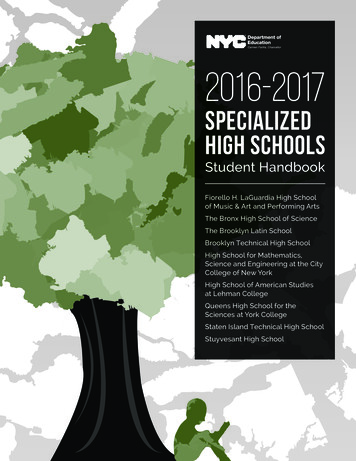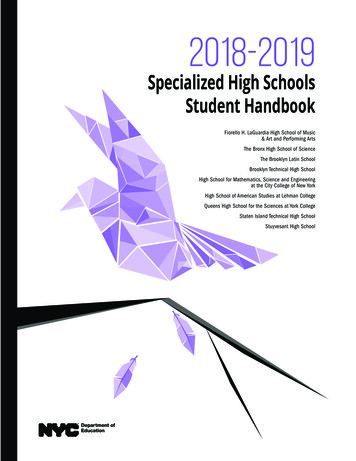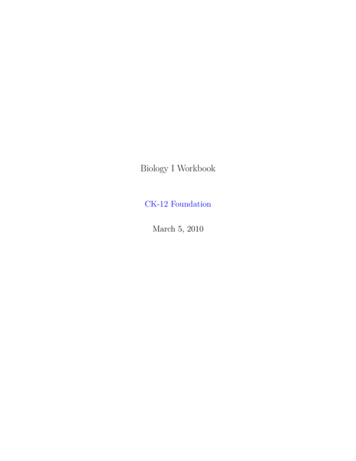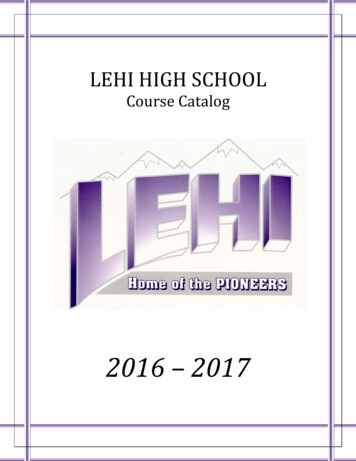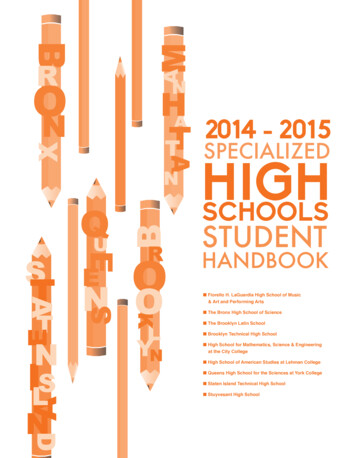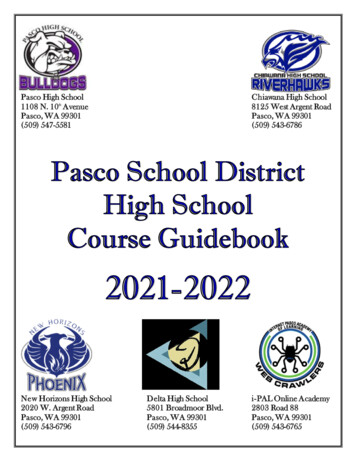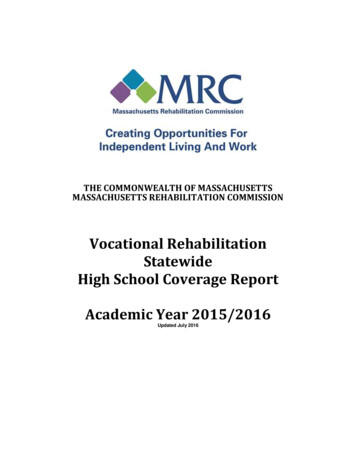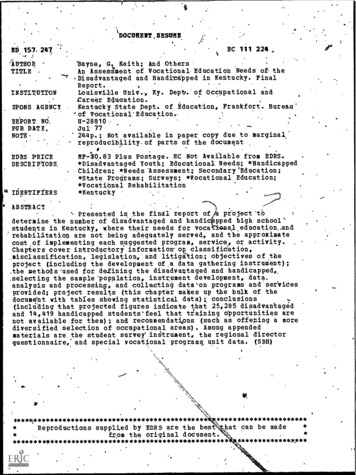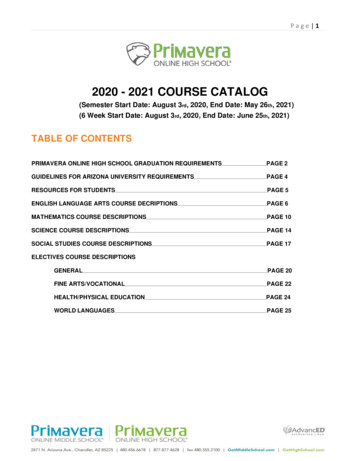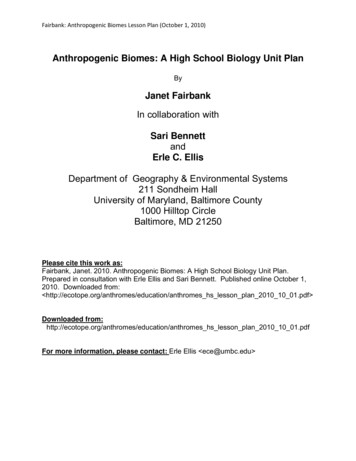
Transcription
Fairbank: Anthropogenic Biomes Lesson Plan (October 1, 2010)Anthropogenic Biomes: A High School Biology Unit PlanByJanet FairbankIn collaboration withSari BennettandErle C. EllisDepartment of Geography & Environmental Systems211 Sondheim HallUniversity of Maryland, Baltimore County1000 Hilltop CircleBaltimore, MD 21250Please cite this work as:Fairbank, Janet. 2010. Anthropogenic Biomes: A High School Biology Unit Plan.Prepared in consultation with Erle Ellis and Sari Bennett. Published online October 1,2010. Downloaded from: http://ecotope.org/anthromes/education/anthromes hs lesson plan 2010 10 01.pdf Downloaded mes hs lesson plan 2010 10 01.pdfFor more information, please contact: Erle Ellis ece@umbc.edu
Fairbank: Anthropogenic Biomes Lesson Plan (October 1, 2010)Anthropogenic Biomes: A High School Biology Unit PlanImage from: http://ecotope.org/projects/anthromes/Purpose: To introduce biology students to a new way to look at the biomes of the earthby studying land areas of the biosphere which include human use. The unitintroduces and incorporates anthropogenic biomes into the ecology unit.Context: Instructional unit for a high school biology class with students in grades 9-12.Unit Plan: Integrates an ecology unit study of biomes which is based on climate andvegetation (the traditional view): tropical rain forest, tropical dry forest,tropical savannah, temperate grassland, temperate forest, temperatewoodland and shrubland, desert, Northwestern coniferous forest, borealforest (tiaga), and tundra Introduces students to these ‘human included’ environmental systems calledanthropogenic biomes which have human interactions incorporated into theenvironmental system – the Anthropogenic Biomes: urban areas, villages anddense settlements which vary between crops and ranges, croplands whichvary between rainfed and irrigated areas, rangelands and forested landswhich vary between populated and remote. Introduces students to organisms which live within and have adjusted toenvironmental systems which humans are using Is planned for five 55 minute lessons, a study day and a presentation day.
Fairbank: Anthropogenic Biomes Lesson Plan (October 1, 2010)Summary of the Unit PlanStudents will demonstrate their understanding ofeach anthropogenic biome by:- analyzing the biotic and abiotic factorswhich determine the survival andgrowth of various organisms foundwithin each biome- analyzing the relationships betweenthe different organisms and humanactivity- explaining ecological succession andcomparing the stages to land areaswithin a biome Day 1: The introduction to the unit will encompass a brief review of thetraditional biomes. Students will then be introduced to the anthropogenicbiomes. These biomes include: Forested Biome, Rangeland Biome,Cropland Biome, Villages Biome and Urban Biome. Days 2: Students will study the natural history traits of the organismswithin the Forested Biome. Day 3: Students will study the organisms within the Croplands Biome.They will then analyze the adaptations and the interactions of theorganism (predator/prey, competition, emigration, niches, habitats,symbiosis, mutualism and parasitism). Day 4: Lab - Students investigate varying soils and moisture conditions onworms and seed samples. Day 5: Students will define the concept of ecological succession andexplore interactions of the mouse and ant populations within the VillageBiome. Day 6 and 7: At the conclusion of the unit the students will demonstratetheir knowledge by applying what they have learned in a small groupproject.
Fairbank: Anthropogenic Biomes Lesson Plan (October 1, 2010)This unit introduces the anthropogenic biomes to studentsthrough the website “Anthropogenic Biomes” by Erle C.Ellis and Navin Ramankutty athttp://ecotope.org/projects/anthromes. The unit planincorporates a high school text and the accompanyingcompact disc from Biology by Miller & Levine (Prentice Hall2008). The accompanying disc provides an interactivepower point and questions which follows the textbook.Chapter 4 from the text is integrated with the introductionof the anthropogenic biomes. The lessons from of the unit plan covers the concepts andvocabulary from Chapter 4 – Ecosystems and Communities. Other websites forstudents’ use approved by the Howard County Department of Education are alsoutilized as well as related articles and chapters from books listed in the bibliography.Various resources integrate the concept of anthropogenic biomes within the guidelinesof the approved science curriculum required by the Maryland State Goals andObjectives.
Fairbank: Anthropogenic Biomes Lesson Plan (October 1, 2010)Lesson Plan Day 1Description: This lesson reviews biomes and introduces the new concept ofanthropogenic biomes. Activities are included which reinforce vocabulary whichstudents should have some prior knowledge of and introduces new vocabulary. Afterthey have an understanding of the abiotic and biotic factors in a biome, they have theopportunity to apply their knowledge by completing a group brief essay.Goal:The student will demonstrate the ability to distinguish the anthropogenic biomes fromthe traditional biomes and to analyze the relationship among organisms to the abioticfactors and biotic factors related to them.Objectives:Students will:1) define traditional biomes (cold and tropical forests, deserts, grasslands, savanna,taiga, tropical rainforest, and tundra)2) describe the Anthropogenic Biomes (dense settlements, villages, croplands,rangelands and forested areas)3) compare/contrast traditional biomes with the anthropogenic biomes.4) define abiotic and biotic factors which determine the survival and growth of anorganism and the productivity of the ecosystem in which the organism bioticdense icwildlandsMaterials Needed:1. Computer and LCD projector2. Power Point Disc - Prentice Hall Disc #13. Anthropogenic Biomes Website4. Worksheets 1.1, 1.25. Biology (Prentice Hall, 2008) Student and Teacher TextPrior Knowledge:Students have already learned about the levels of organization which ecologists studyChapter 3. Students should have pre-read Chapter 4.3 Biomes (pages 98-105), andhave an understanding of the following vocabulary:Canopy, understory, deciduous, coniferous, humus, tiaga, permafrostDrill/Warm Up:Students start a KWL (worksheet 1.1)
Fairbank: Anthropogenic Biomes Lesson Plan (October 1, 2010)Students will review Chapter 4.3 Biomes (pages 98-105) and read Chapter 4.2 (page 90)Biotic and Abiotic FactorsInformation Delivery/Guided Practice:Introduction:- students view Power point Prentice Hall, Presentation Express 4.3 Biomes(relevant terms, review of biomes)- conduct a clicker question and answer period to determine prior knowledge oftraditional biomes. Review any terms which are still unfamiliar to students,provide examples- handout Worksheet 1.2, students will complete Part 1Part 1:-View Encyclopedia Earth – Terrestrial Biomeshttp://www.eoearth.org/article/Biome.View Discovery News Videos, Earth: Human Influence on Ecology -influence-on-ecologymapped.html.View Encyclopedia Earth - Anthropogenic Biomes – Education and Researchpower point from http://www.eoearth.org/article/Anthropogenic biomes. slides8-20List each biome on the board; have students describe animals/plants whichwould be found in each biomePart 2:-students view Power point Prentice Hall Presentation Express 4.2 Whatshapes an Ecosystem, slides 1-10 (Abiotic/Biotic Factors)- students define the abiotic and biotic factors which affect these organisms,write on boardDiscussion:- How have organisms adapted to the Anthropogenic Biome?- Do the organisms which live within the traditional biome exist in theAnthropogenic Biome? Do they exist in more than one? Why or why not?- Do these systems promote diversity and richness to these biomes? How?- Describe the richness that has been added to the anthropogenic biomes.- Have we introduced species that don’t belong to these areas?- Describe how some are invasive but many have enriched the system.Independent Practice/Assessment:Students work in groups of three, and complete the following:- Complete Worksheet 1.2 part II- Evaluate and list how the traditional biomes differ from the anthropogenicbiomes.- Describe an organism within an Anthropogenic Biome that was not originallyfrom the area. Has it been a benefit, a nuisance, or neither – explain.Closure: Students share with the class.
Fairbank: Anthropogenic Biomes Lesson Plan (October 1, 2010)Lesson Plan Day 2Description: This lesson introduces the Forested Biome. Students will build on theirprior knowledge of Ecology (Chapter 3) by applying vocabulary to the Forested Biome.Various activities help students to organize key factors when evaluating an organismwithin this biome.Goal:The student will demonstrate the ability to analyze the relationships among organismsand between organisms and abiotic factors within the Forested BiomeObjectives:Students will:- organize organisms in the forested biome (producer, consumer, etc.)- define a niche and describe the conditions which cause organisms to form aniche- define the natural history of an organism–description of traits and populationcharacteristics of single species (herbivore, carnivore)- research the natural history of the deer.- have an understanding of specific traits of the organism: preferred habitat (different at different life stages or seasons?) preferred food(s) age at sexual maturation mating seasonVocabulary:HabitatNicheMaterials Needed:1. Computer and LCD projector2. Power Point Disc - Prentice Hall Disc #13. Anthropogenic Biomes Website4. Worksheets 2.1 (Crossword Puzzle) and 2.2 (Wolves)5. Biology (Prentice Hall, 2008) Student and Teacher TextPrior Knowledge:Students have already learned about the levels of organization which ecologists studyand the natural history of an organism from Chapter 3. Students should have anunderstanding of the following vocabulary:Producer, consumer, decomposer, autotroph, heterotroph, herbivore, carnivore,detrivore, omnivore, photosynthesis
Fairbank: Anthropogenic Biomes Lesson Plan (October 1, 2010)Drill/Warm Up:- Students read pages 91-92 in textbook (Niche)- Students complete Worksheet 2.1 Crossword PuzzleInformation Delivery/Guided Practice:Introduction:Discussion (Review Niche)- How would you describe a niche?- What factors may cause organisms to form niches?- How is a habitat different from a niche? (ex: Warbler family feeds at differentparts of the spruce tree however have the same habitat)- How can niches of the Warbler family be affected in an anthropogenic biome?(ex: land use changes; new subdivision of homes takes all trees down versusbuilds among the trees)Part 1:- view Anthropogenic Biomes – Forested d/default.aspx.- review of abiotic factors (temperature, precipitation, wind, nutrients in biome)and biotic factors (ecological community) within this biomeAsk:- What abiotic and biotic factors do deer require?- Describe deer habitat.- What do deer need to survive?- List events in deer natural history- preferred food(s)- preferred habitat (different at different life stages orseasons?)- age at sexual maturation- mating season- How do deer and humans cohabitate in the forested biome? (deer for hunting:man and prey, deer forage in scrub, in gardens, etc.)- Have deer developed a niche within the forested biome?- Can you describe where deer have developed a niche?Part 2:- Students read page 128 of text about wolves.– Enter the wolf, brief history of the wolf and where they are foundClosure/Assessment:Quick Jot – Name one organism within the forested biome.Is it a consumer/producer, herbivore/carnivore?Describe the abiotic factors that this organism prefers.Describe organism’s positive/negative interactions with humans.Independent Practice:Homework Student research: WolvesHand out to Students Homework Worksheet 2.2 Wolves
Fairbank: Anthropogenic Biomes Lesson Plan (October 1, 2010)Lesson Plan Day 3Description: This lesson introduces the (optional: rangelands and) croplands biomeand focuses on the interactions of the organisms within their community and with otherorganisms. The Anthropogenic Biomes web information continues by introducing thestudents to the croplands biome. There are two parts to this lesson including a lab onday 2. Discussion provides students with examples of predator/prey and competition.Students will use a website which provides visual examples of land use described withinthese biomes. Students will explore a worm, different soil types and germinated rice andrye plants in a terrarium activity to predict and to analyze the interactions observedwithin this habitat.Goal:The student will demonstrate the ability to analyze the community interactions amongand between organisms and between humans within the croplands biome.Objectives:Students will:- analyze the organisms’ adaptations from forested biome to a habitable areawithin the cropland biomes- analyze the different factors which define the croplands biome- describe the Community interactions of the organism (Competition, predation,symbiosis ) with another organism (plant and animal) and with biosisMutualismCommensalismParasitismMaterials Needed:1. Computer and LCD projector to show Power Point2. Power Point Disc - Prentice Hall Disc #1and3. Anthropogenic Biomes Website4. Worksheet #35. “Cornworm” story from Gilbert Waldbauer’s Insights from Insects: What BadBugs Can Teach Us6. Textbook, Prentice Hall Biology7. Lab book, Prentice Hall BiologyDrill/Warm Up:Question on board: What types of plants grow in the forested biome? What types ofindigenous (native) plants would you find growing within the croplands biome? Name a
Fairbank: Anthropogenic Biomes Lesson Plan (October 1, 2010)type of crop. Can you think of an organism that can be found living in one of these areasor in both? Describe it.Information Delivery/Guided Practice:Part 1“Wolf” Homework reviewPlace students’ answers in categories on the board: Abiotic (vegetation, temperature)& Biotic (predation vulnerability, parasite/disease susceptibility) Factors, Habitat, Naturalhistory, interactions with deer, interactions with humans, otherPart 2A) Students read pages 92-93 in textbook (Community Interactions)B) Students View Power Point PH 4.2 – Slides 12 – 29 (Community Interactions)Discussion:How might these species interact?- Competition: Mice and rats - Two organisms require the same resource. Maybe interspecific or intraspecific (define)What kinds of resources might these organisms compete for?- Predator/Prey: Corn snake / Field Mouse - Trophic levels, transitions betweenthem.- Commensalism: Orchids / Trees - One organism benefits and the other isunaffected.- Parasitism: Ticks / Humans - One organism benefits at the expense ofanother organism, short of predation.- Mutualism: Both organisms benefit from the relationshipC) Assessment Handout Worksheet 3.1 – Students complete first sectionD) (Optional) View Anthropogenic Biomes – ngelands/default.aspx.Discussion:Describe the different types of rangelands.What factor predominately divides this biome?E) View Anthropogenic Biomes – plands/default.aspx. Interactive GoogleEarth which shows examples of today’s croplands –Students Complete WorksheetDiscussion:- How are the biomes within the Croplands biome described?- How have these biomes transitioned from the grassland biome?- Describe the landscape.- Highlight pertinent facts about corn: Science Explorer: From Bacteria toPlants, (Prentice Hall 2002) pages 174 – 180.- Which factor was present within this biome that was not in the forested biome?What was missing?- What benefits do the croplands (and rangelands) biomes provide to humans?To other organisms?
Fairbank: Anthropogenic Biomes Lesson Plan (October 1, 2010)-Would you find the deer and wolf in these biomes? Why or why not?What is their behavior and interactions with other organisms in this biome?Why?How would you describe the organisms which live in the croplands biomes?How would you describe human interactions with organisms in this biome?Describe a community of (organisms) within (rangelands and) croplands(What organism lives on the rangelands? Is it there naturally?)What types of organism would you find living in croplands?Independent Practice / Assessment:Students complete 3.1Closure:Review:- highlights from the story about the “Cornworms” from GilbertWaldbauer’s Insights from Insects: What Bad Bugs Can Teach Us.Students- define the community interactions in relation to the cornworm- describe the adaptions that the cornworm has made- list the positive/negative effects that the cornworm has to the ecosystem(including to humans)Homework:Students complete 3.2
Fairbank: Anthropogenic Biomes Lesson Plan (October 1, 2010)Lesson Plan Day 4 - LabDescription: (See Lesson Plan Day 3)Goal:The student will demonstrate the ability to investigate how changes in environmentalconditions and human activity will affect the earthworm and plant samplesObjectives:Students will:- Analyze the two types of organisms (plants, worms) in different soil type, inthe presence of acid, with disturbance, and with varying amounts of moistureMaterials Needed:Case Study to demonstrate the abiotic/biotic factors/environmental/humaninteractions and conditions- Terrariums – set up two weeks prior – two terrariums1) different soils and rice and rye seeds and2) different soils and earth worms.(http://docs.google.com/viewer?a v&q /Curriculum/worms/98Activities.pdf).Drill/Warm Up:Warm up – Review of the natural history and physiology of the earthwormInformation Delivery/Guided Practice:Terrarium experiment and observations – students will observe and analyze the growthof the rye and rice and the behavior of the earthworms as described in the lab bookletIndependent Practice/Assessment:Students complete Worksheet 4.1Closure:Discuss:- Which soil did the earthworm prefer?- Which soil did the crops prefer?- What happened when Acid was introduced to both environments?- Why do we need the earthworm?- Did moisture make a difference? If so, how?- How would plowing a field affect the earthworm?- What are farmers doing today to work with the habitat?- In what areas of the world do these seeds grow?- Are these grains used to sustain the local population or the global population?- Would you consider the croplands or rangeland biomes as efficient land use?Why or why not?
Fairbank: Anthropogenic Biomes Lesson Plan (October 1, 2010)Homework:¾¾¾¾¾¾StudentsRead Textbook Chapter 28-3 “Ants”Find a community of ants and describe what you seeList the benefits ants contribute to the environmentDescribe any damage that they may do to your environmentDescribe what we use to control their interactions with our environment.You are taking a walk in a park and come across and an ant hill. Describeyour thoughts towards this ant population. (at least one paragraph)Resources:An Ant Colony by Fischer‐Nagel, Heiderose, and Andreas Fischer‐Nagel
Fairbank: Anthropogenic Biomes Lesson Plan (October 1, 2010)Lesson Plan Day 5Description:This lesson develops a basic understanding of how environments go through differentstages of ecological succession. The ant and mouse will be examined within the VillageBiome. The unit is concluded with a final activity. This activity incorporates thevocabulary learned into the anthropogenic biomes by having the students create eithera poster project or small report. The students will have an opportunity to explore ananimal of their choice and research their animal and the community interactions.Goal:The student will demonstrate the ability to analyze the interrelationships andinterdependencies of the ant and mouse populations within the Villages biome.Objectives:Students will-explain how an ecosystem goes through various stages of stability after acatastrophic disaster: ( Primary succession, Secondary succession)analyze the villages biome and compare the land areas to successionanalyze the interactions of the mice and ant populations with humans andwithin the villages biomeVocabulary:ResourceCompetitive exclusion principleEcological successionPrimary successionSecondary successionPioneer speciesMaterials Needed:12345Computer and LCD projector to show Power PointPower Point Disc - Prentice Hall Disc #1Anthropogenic Biomes WebsiteProject Worksheet 5.1Textbook, Prentice Hall Biology
Fairbank: Anthropogenic Biomes Lesson Plan (October 1, 2010)Drill/Warm Up:Question to students, write answers on the board1. Describe where you live. Are there a lot of homes, stores and concrete? Whattype of vegetation can be found?2. If you travel ½ hour away from your home, what does the landscape look like?Describe the neighborhood, the spacing between the homes, and the vegetation.Information Delivery/Guided Practice:Part IView Power Point Prentice Hall Presentation Express 4.2 – Slides 30 – 35(competitive exclusion principle, ecological succession)Students to complete clicker questions at the end of the slidesQuestion –- If a section of cropland were to be destroyed by fire, describe the stages ofecological successionPart IIView Anthropogenic Biomes – ages/default.aspx.Discuss:-The differences between the various villages. Would we find deer, wolves,mice and ants within these settings? Why or why not?Describe the varying stages that can be seen.How is land transformed / utilized?Is land abandoned in the Villages Biome?Describe the vacant land.Compare the vacant land to the cultured landWhy is there vacant land?Does this vacant land provide a service? To what / whom?What other types of organisms would you find in the vacant land?Review article: "The Ecology of Small Mammals in Urban Habitats: Populations in aPatchy Environment."-What benefit do mice, shrews, and voles provide to the anthromes? To thevillages biome?Describe how the competitive exclusion principle is exercised within thisbiomeDescribe how these animals have interacted with humans. Are some ofthese animals dependant on humans?How are these lands dissected?
Fairbank: Anthropogenic Biomes Lesson Plan (October 1, 2010)-Within the villages biome, vacant land is seen throughout. Describe thestages of ecological succession which an abandoned farm would follow.Review article: “ The last mile: How to sustain long-distance migration inmammals.”-Do you think that the vacant lands could be patterned within the villagesand even the croplands and rangelands biomes to create connections fororganisms to travel safely?View: lesnakes-road-genetic-diversity.html-What effect do roads have on organisms?Do you think that these vacant lands may be utilized by organisms as apathway to and from other habitats?How often do you see dead animals on the sides of the roads?How do these animals cross the roads?Can you think of a worthy plan to help organisms travel across roads?View: Land ://www.patagonia.com/web/us/patagonia.go?slc en US&sct US&assetid 27902Independent Practice/Assessment:Review:-Science Explorer. Animals (Prentice Hall 2002) pages 62 – 67 “Insects”.Students share their short paragraph from the previous night’s homeworkin groups of four.Students evaluate the pros and cons of ants within this biome anddescribe the ‘ultimate’ balance for humans and ants in an Extended ShortAnswerClosure:- Students share and paraphrase ESA- Introduce unit assessment (worksheet 5.1)Unit Assessment:- Unit project, Worksheet 5.1 – Student Project- Go over explanations, expectations and rubricDay 6 – Day in Library / Day 7 – Presentations
Fairbank: Anthropogenic Biomes Lesson Plan (October 1, 2010)(Worksheet 1.1)NameKWL1. Describe what you know about each of the following words or phrases2. Describe what you would like to learn3. When the lesson is done, describe what you have learned.Word or PhraseWhat you knowWhat you want toWhat you haveknowlearnedBiomesAnthropogenicBiomesAbiotic factorsBiotic factorsNiches
Fairbank: Anthropogenic Biomes Lesson Plan (October 1, 2010)(Worksheet 1.2)NameWe will discuss the following traditional biomes.As we discuss these biomes, fill in the categories below:Abiotic Factors PredominantPredominantPlantsAnimalsTropical erateGrasslandGeographicDistribution
Fairbank: Anthropogenic Biomes Lesson Plan (October 1, 2010)We will discuss the following Anthropogenic Biomes.As we discuss the Anthropogenic Biomes, fill in the categories below:Abioitic tion
Fairbank: Anthropogenic Biomes Lesson Plan (October 1, 2010)NameCrossword Puzzle Page 1Worksheet 2.1Anthropogenic Biomes
Fairbank: Anthropogenic Biomes Lesson Plan (October 1, 2010)Across4. Another term for anthropogenic biomes6. Activity between humans and organisms8. Organism which has found an area that no others share has developed this11. Collection of interbreeding organisms of a particular species12. Cities14. Villages are found here16. Physical and biological components of an environment18. Human factors on land use have created anthropogenic biomesDown1. Mixture of crops within settlements2. The landscape from above would be described as this3. Anthropogenic biomes divides 21 classes within 6 large groups4. Natural environments where an organisms live5. Single or multi-celled living system7. Temperature and climate9. A human feature found within all anthromes10. Describes the majority of land use which are cultivated and include 1/4 global tree cover13. Roads through forested biomes cause this feature15. The population at the sprawling edges of a city17. Where you would raise /CrissCrossSetupForm.asp
Fairbank: Anthropogenic Biomes Lesson Plan (October 1, 2010)KeyAcross4. Another term for anthropogenic biomes – humanbiomes6. Activity between humans and organisms - interaction8. Organism which has found an area that no others share has developed this - niche11. Collection of interbreeding organisms of a particular species - population12. Cities - urban14. Villages are also described as this - settlements16. Physical and biological components of an environment - ecosystem18. Human factors or on land use have created anthropogenic biomes influencesDown1. Mixture of crops within settlements - villages2. The landscape from above would be described as this - mosaic3. Anthropogenic biomes divides 21 classes within 6 large groups - anthromes4. Natural environments where an organisms live - habitats5. Single or multi-celled living system - organism7. Temperature and climate are what type of factors - abiotic9. A human feature found within all anthromes - roads10. Describes the majority of land use which are cultivated and include 1/4 global treecover - croplands13. Roads through forested biomes or connecting farms cause this feature - segmented15. The population at the sprawling edges of a city - dense17. Where you would raise livestock – m/CrissCrossSetupForm.asp
Fairbank: Anthropogenic Biomes Lesson Plan (October 1, 2010)NameHomework (Worksheet 2.2)WolfExtended Response (Essay)Research the natural history and physiological features of wolvesYou may use the approved online resources. The books listed below may also be used.Your Paragraph should address the following points:Describe habitat, abiotic and biotic factors needed for survivalList wolf natural historyDoes their habitat include humans?How do wolves cohabitate with both man and deer, or do they?Approved books:Dudley, Karen. Wolves. Austin, Tex.: Raintree Steck-Vaughn, 1997. Print.Lawrence, R. D. Wolves. San Francisco: Sierra Club, 1990. Print.Patent, Dorothy Hinshaw., and William Mun?oz. Gray Wolf, Red Wolf. New York, N.Y.:Clarion, 1990. Print.
Fairbank: Anthropogenic Biomes Lesson Plan (October 1, 2010)Name(Worksheet 3.1)List the other five community interactions and provide an example in eachcategory:Animal CompetitionPlantAnimalHumanDescribe below the differences between the various latedRemoteOn the back of this page, describe briefly how humans have transformed grasslands:
Fairbank: Anthropogenic Biomes Lesson Plan (October 1, 2010)(Worksheet 3.2)NameFind a word from this unit that matches the following letters and write a briefdescription of it in the space on the graph. Provide page numberABCDEFGHIJKLMNOPQRSTUVWX or YY or Z
Fairbank: Anthropogenic Biomes Lesson Plan (October 1, 2010)Name(Worksheet 4.1)WormRiceRyeSandy soilPotting soilDamp environmentDry environmentSolution with diluted HCLDisturbance:- Sound-Vibration-MovementConclusions:
Fairbank: Anthropogenic Biomes Lesson Plan (October 1, 2010)Name(Worksheet 5.1)Project – Written or Oral Report, Poster, Brochure, News Article, or WebsiteDirections: Find an organism of your choice and have it approved by your teacherDecide on a form for your project:- brochure- poster- report- newspaper article- websiteResearch your organismWithin your choice of project, address the following questions/topics for your organism:1) Define the abiotic and biotic factors which determine the survival and growth ofthe organism and the productivity of the ecosystem in which the organism lives2) Explain the natural history of the organism3) Describe the anthropogenic biome your organism
Department of Geography & Environmental Systems . 211 Sondheim Hall . University of Maryland, Baltimore County . 1000 Hilltop Circle . Baltimore, MD 21250 . Please cite this work as: Fairbank, Janet. 2010. Anthropogenic Biomes: A High School Biology Unit Plan. Prepared in consultation with Er
